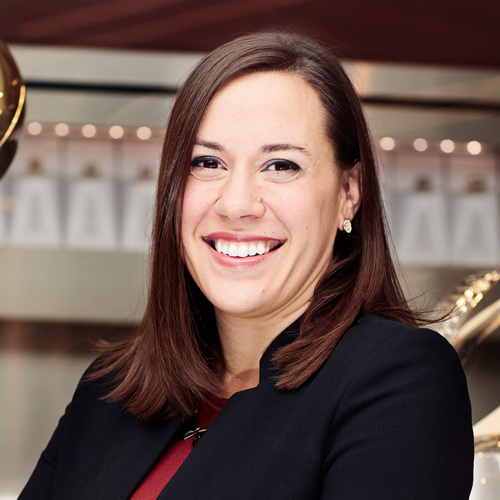For Thomas Santiago, in the battle of Wall Street versus Hollywood, Hollywood won.
Before joining Time Warner as senior vice president and global real estate head, Santiago was a leader in corporate real estate (CRE) with financial giant Citigroup. At the multinational banking institution, Santiago worked his way up to the head of North American real estate and managing director, where he oversaw a 35-million-square-foot portfolio with a $1.3 billion annual operating budget and several hundred employees. But after more than twenty years with Citigroup, Santiago was ready for a new challenge.
“Full disclosure: I didn’t know what I wanted to do,” Santiago says. “I wasn’t quite sure I wanted to work at another big company, and I was pretty sure I didn’t want to work for another bank.”
Then Time Warner called.
“The technical aspects of the job were, in many ways, the same,” Santiago says. “But everything else is different—especially the culture. It’s Hollywood, not Wall Street. I was brought up in a more formal banking environment, but I was certainly not a banker. So, Time Warner was intriguing because it was culturally a very different place.”
On September 12, 2011, Santiago officially joined Time Warner, overseeing its real estate operations and tasked with creating a global real estate organization across the company. This meant being responsible for the hundreds of properties in more than fifty countries, where thousands of employees work every day. This includes everything from leasing, buying, selling, renovating, and maintaining buildings to all the physical details that allow a business to operate including dealing with vendors and landlords.
“As things get bigger and more complicated, you need more people, and more sophisticated management,” Santiago says. “That’s corporate real estate, and that’s what I do.”
Santiago’s interest in corporate real estate grew after joining his then father-in-law in the high-rise construction business, where he quickly progressed from construction manager to layout engineer to project manager before eventually shifting his interest to a passion for commercial real estate.
“It was a natural progression given I was working on large buildings all the time and was analytical by nature,” Santiago says. “I didn’t know I would find a passion, but sometimes careers choose you and that was true with me.” Santiago decided to later round out his credentials, graduating magna cum laude from New York University with a concentration in real estate.
It was at Citigroup that he developed a high tolerance for scale and broad responsibility, not to mention the sheer volume of work required to make it at such a big place. He also learned the business side of CRE and the importance of financial management, and thinking of it as any other business.
“At Citi, I learned to be a business manager who specialized in real estate management, encouraged and mentored into coming to work every day and thinking like an owner,” he says. “And I am so grateful for that experience, and for having worked with great leaders who taught me and understood that a company’s occupied real estate could be as important an asset as any other.”
Santiago brought these hard-earned skills and leadership lessons with him to Time Warner. He worked with his new team to form a global, center-led shared services operation out of what had been a disparate real estate organization, all while planning and executing the long-term master plans for Time Warner’s major global hubs.
“By creating great environments where employees can do their best work—that’s ultimately about enabling a great employee experience.”
– Thomas Santiago
The Manhattan Project
For the past six years, Santiago has been the man behind one of the most scrutinized and large-scale Manhattan office space projects in recent history: the long-term plan for Time Warner’s New York operations, comprising the various divisions such as HBO, Turner Broadcasting Systems, Warner Bros., and Time Inc., until spun off in 2014. Four million square feet of real estate that housed more than eight thousand full-time employees had to evaluated for potential renovation, relocation, or consolidation.
First, Time Inc., after its spin-off, moved to a location in Lower Manhattan. “That was a game changer because they were in the namesake Time and Life building for decades, yet embraced the need for a major reset,” Santiago says.
In 2019, the remaining workers are scheduled to move from eight buildings to a single one at the Hudson Yards on Manhattan’s west side. “It is a major, transformational real estate event, which will have a profound impact both on today’s workforce and on the next generation of our businesses and employees,” Santiago says. “We’re putting together all these businesses that weren’t historically together under one roof.”
The process is obviously a major undertaking that required approval of Time Warner’s Board of Directors, to whom Santiago presented the project himself. “The outcome was not pre-ordained,” he says. These are decisions companies have to live with for decades, so it takes time to get the planning right, which meant Santiago and his team needed to start several years early.
To make everything happen, he and his real estate team had to study a workforce of thousands, evaluate many markets, ideate a new workplace strategy, sell a building, buy a building, lease another, and plan an orderly exit of several leases. Then there was the actual design of the workplace and the procurement process, the actual construction management, and the eventual logistical challenge of migrating thousands of employees. According to Santiago, especially at large companies, this complicated relay race simultaneously plays out dozens to hundreds of times across multiple projects on a scale both large and small.
Add to that, that he had no hard directive other than to “develop and drive an intelligent and transparent process,” which made for a longer journey but aligned well with Time Warner’s inclusive and deliberative culture. In the end, it was worth it.
“Given the amount of properties and potential employee relocations involved, the plan had the makings of a market-moving event,” Santiago says. “The city was abuzz with chatter and curiosity, with landlords and developers and government officials clamoring for attention. And for somebody in my job, it was a Shangri-La situation with a CEO and CFOs [Jeff Bewkes and at the time, John Martin and later, Howard Averill] who were totally supportive without dispensing mandates to do this or that, or end up with this or that outcome.”
Outside of New York, Santiago and his team continue working on other large- to medium-scale master plans in Atlanta, Burbank, London, Hong Kong, and more. The guiding principle here is to, over time, create and proactively plan a highly functioning network of properties in support of a great network of employees and businesses.
Built to Last
Because it affects nearly every individual in an organization, real estate is as much about building relationships as it is about building buildings. “Relationship management, credibility, and trust is a big deal here,” Santiago says. “Building relationships is placed at a premium.”
One of the challenges—as well as one of the benefits—of working at a global media company like Time Warner is the different divisions that are part of the whole. Turner Broadcasting—including CNN, HBO, and Warner Bros.—bring their own cultures with nuanced and proud histories, so being respectful and thoughtful, and just plain listening, are essential to navigating them.
“One of the idiosyncrasies of the Time Warner culture is that it’s about original programming, film, news. It’s entertainment, and it’s the cable networks,” Santiago says. “To create the best content and tell the best stories, you need lots of diverse opinions.” Because of that, Time Warner and all of its divisions are deep wells of diversity.
“As a Latino executive, I feel part of an equal playing field here,” Santiago says. “I feel sponsored and welcome by leadership, but it’s not just me. It is a wonderfully diverse place, no matter where you are from, or what your orientation is.”
The Keys to the Kingdoms
While corporate real estate is Santiago’s craft, he considers himself to be, above all else, in the employee experience business. “By creating great environments where employees can do their best work—that’s ultimately about enabling a great employee experience,” Santiago says.
To create that kind of environment, Santiago believes that the real estate team must work hand in hand with human resources and the information technology teams by developing and following a common collaboration protocol that emphasizes the employee experience.
“There are lots of other things each of these functions are responsible for, but insofar as how they intersect where workplace solutions are concerned, the fiefdoms have to get put to the side and workplace solutions are needed which put the employee at the center,” Santiago says. “It is not enough to design great space. It has to be properly planned and programmed along several dimensions—with great technology and employee policy—because talent will increasingly demand and gravitate to environments and solutions and tools, which are highly stimulating and supportive of the new ways of working.”
“Corporate leaders may think they have a choice, but they will ignore the strategic import of the workplace at their peril and, I believe, lag in the war for the best people if they do,” he concludes.
On October 22, 2016, AT&T announced its $85 billion plan to acquire Time Warner. While the benefits for both organizations have been widely reported, Santiago says that for Time Warner’s CRE function, it creates an opportunity for AT&T to leverage all the workplace innovation Time Warner has already undertaken with its own efforts to create great work environments. As for his role in the potential blockbuster, it has been to lead and support the real estate-related discovery that goes into buying and selling and transitioning any company from the Time Warner side.
Regardless of what the future holds, having thus far primed his muscles on nearly thirty million square feet and $9 billion of career transactions and projects, Santiago will continue his passion of pursuing strategic real estate solutions and creating great workplaces.
 Thoughts from Guest Editor Javier Palomarez
Thoughts from Guest Editor Javier Palomarez
“Tom’s careful dedication to the safety, comfort, and productivity of thousands is no small feat. While most of us may not recognize the meticulous planning that goes into our physical work space, we certainly know when something is amiss. Thanks to his leadership, Tom’s colleagues are able to work in an environment that allows them to perform at their best. Through his years of successful work in the field, Tom understands the value of diversity—of all kinds, including diversity of thought. It is his empathy as a leader that serves him and his industry well. A worthwhile lesson for us all.”
Tom, congratulations being featured in Hispanic Executive magazine. Well deserved! You have been a valued client, partner and colleague over many years. I’m looking forward to continuing our work with you and successfully completing Time Warner’s new Headquarters.” —John Robbins, Managing Director, USA, Turner & Townsend
CBRE congratulates Thomas Santiago on his many achievements as Global Real Estate Head for Time Warner. It’s been our great pleasure to help realize Tom’s ongoing vision for Time Warner, including its state-of-the-art new home at 30 Hudson Yards. A Fortune 500 and S&P 500 company, CBRE is the world’s largest commercial real estate services firm, with more than 75,000 employees serving real estate investors and occupiers through 450 offices worldwide. From investment sales and leasing transactions to outsourcing and advisory services, CBRE delivers advantage for every client we serve. Visit us at http://www.cbre.us/.

